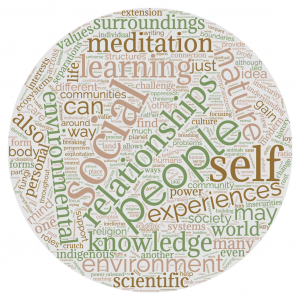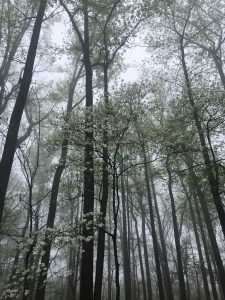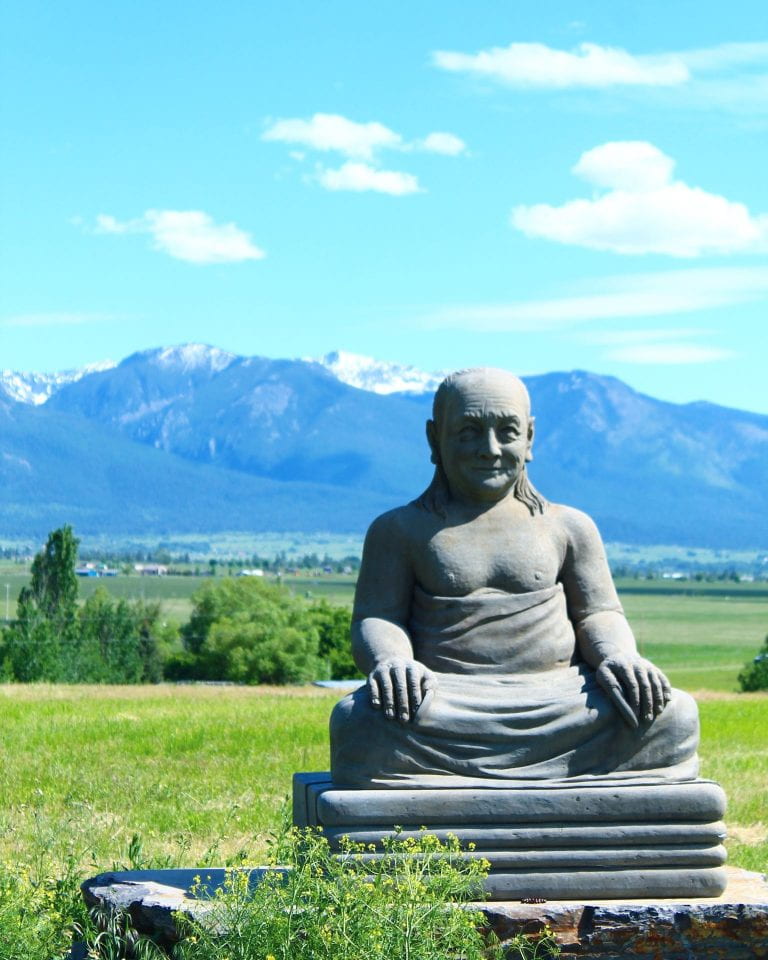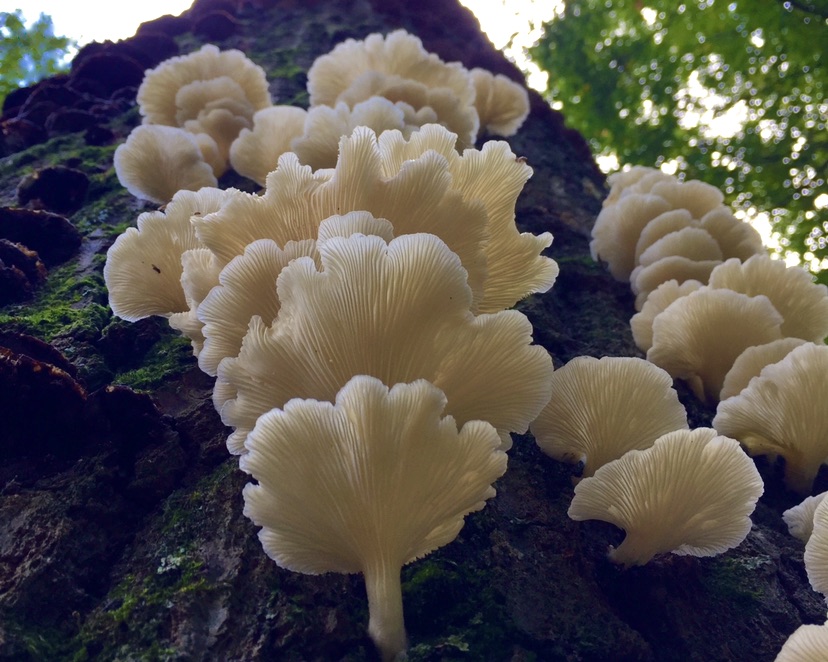21 Shifting Focus: Meditative Reflections on the Self and Connectedness
Justin Smith

Hello! I’m Justin Smith. The topic of meditation and connection became incredibly important to me this year as I worked to find new ways to take care of my mental health, stand up for my values, and learn about other people in the face of global crises. By connecting different perspectives on the idea of the self and comparing them to my own experiences, reflection and meditation provide meaning, purpose, and understanding of community…read more.

In the beginning of a meditation, focusing on breathing provides rhythm and a connection between body and mind. My experiences in both guided and solitary meditation begin this way to ground myself and clear my mind, accepting any thoughts that may come through but not dwelling on them. From this awareness of breath, attention is then shifted throughout the body, gradually working from the feet to the forehead. Now that I have pushed up against the boundaries of my body, the next step is to reach out just past myself and focus on the space around me. But what are these boundaries? Meditation practices have roots in various religious ideologies, which analyze these boundaries and deconstruct the notion of the self. While I usually avoid having an end goal in my own meditation, learning about the dissolution of the self has changed my perspectives and techniques when meditating, as well as how I think about myself and my place in the world in general. Meditation now serves as a way of opening my mind and breaking down the perceived barriers around me, in a way that allows me to grow and ground myself.

Opening the mind to new forms of learning is not only a meditative practice, but also a reflection of Baer’s challenge to our power-oriented systems of knowledge (1976). The dominant method of searching for knowledge in our culture is focused on ratio thinking, which views learning as a utilitarian, scientific process of acquiring information, power, and control. Baer argues that this paradigm is unbalanced, and we must incorporate more intellectus ways of thinking into our society – being open to new ideas and welcoming experiential learning, with knowledge being valuable by providing a way to grow and build relationships. Meditation practices reflect this intellectus style of learning, as this traditional and spiritual method of interacting with surroundings and learning from the environment allows for growth and exploration without a focus on exploitation.[1]
Academic writing and institutional learning typically discredit personal experiences as forms of learning, advocating instead for strict scientific methods and analyses that limit and detract from the value of knowledge. As Baer might argue, a balance between strictly scientific thinking and purely spiritual/experiential learning may be necessary (1976). This even aligns with the Buddhist idea of The Middle Path, where an ideal route lies somewhere between extremes and is unique to every circumstance (Josephson, 2021). Anecdotal experiences serve to supplement and strengthen academic ones, and the reverse applies as well – my own experiences with spirituality and nature inform my interests and passions, and studying writing and academic work done in these fields has shifted how I view and seek out these experiences.[2]
My investment in the environment stems from a childhood immersed in nature, and was built upon as I learned about other people’s experiences in nature. As someone always focused on fairness, hearing about injustices and social inequity sparked a desire to fight for environmental and social justice. This has allowed my values to overlap and inform each other as I learn more about disparate experiences and long histories of oppression, and find ways to tie them to the systems I live in and am exposed to daily. While my time in formal education has taught me about history and how to analyze these systems, the passion comes from personal interactions with people who have been harmed, and building empathy for everyone experiencing oppression or injustice. This can extend beyond people, but the relationships built with others form the backbone of my passion.
Empathy and justice are not only some of my own core values, but they also find support in many religions. Loy argues that distinctions between the self and others are constructed, and the suffering of others is the same as our own pain and burdens (2010). Many of the oppressive systems marginalized people have suffered under for generations are socially constructed, as are the differences used to justify these systems – although the false justifications of oppression do not make the harms done by them any less real. In this way, while religion has been a contributor to injustice and division, some aspects of it can be used to reconcile harms done. As I have reflected more on religion and spirituality, trying to disentangle my experiences to find more overarching themes, I thought about some of the key aspects of religion. Religion relies on relationships: with ourselves, with others, with life, with the world, with a higher power. These relationships can be the key to rebuilding communities, restoring trust, and reconciling the harms done by separation and oppression.

In my own meditation, not only have I had much more transformative experiences when in the presence of others – be it humans in a guided meditation[3] space, or plants and animals surrounding me in the outdoors – but I have also experienced how a focus on the surroundings allows for more growth. By reaching out and sensing my surroundings, I lose my sense of self, instead feeling the plants, animals, wind, and energy all around me. Breathing now becomes a way of physically becoming one with the environment, as I take in my surroundings through my lungs, and the same air being breathed by all life around me is carried by my blood to every cell in my body. Consciousness shifts away from the individual, blurring the line between body and the rest of the universe – but rather than feeling insignificant, this humbling experience of losing oneself to the universe reveals how we exist as a contribution to the whole.[4] The idea that everything (humans, cells, plants, fungi, animals, atoms) is an extension of the universe’s creative energy gave me peace rather than feelings of insecurity (Loy, 2010). This instills a duty to love everything as an extension of the universe, and therefore an extension of yourself.
Building relationships with others relies on sharing aspects of yourself with them, which in a way starts breaking down barriers. This could be a first step in the dissolution of the self, as we recognize through relationships that we are more connected than we are distinct. Focusing on the self is another moral failure, as it generates insecurities that risk leading to a path of pride and sin (Niebuhr, 1996). Niebuhr discusses how religion can act as a crutch[5] to provide support through the process of breaking down the self, as it answers the fundamental questions and insecurities that may arise if we no longer view ourselves as distinct individuals (1996). Likewise, Loy’s discussion of Buddhist ideologies aligns with these other philosophies in saying that the façade of separation between the self and surroundings only contributes to more suffering (2010).

Despite agreement between different ideologies on the suffering caused by it, the false construction of the self remains a dominant idea in modern culture – particularly our western society. In fact, our current social paradigm emphasizes the distinction between self and other, playing on this divide to influence our beliefs and actions. This can be tied to some of the sins discussed in religious teachings, and Niebuhr’s analysis explores how these sins are derived from our sense of self. Niebuhr argues that human insecurity arises from our freedom to influence the world around us despite the relative smallness of our existence in this world (1996). Human insecurity has led us to seek dominance and power, aiming to fight feelings of insignificance through exploitation and false assertions of superiority. This hunger for power and a place at the top of a hierarchal society has influenced the value we place on knowledge, life, and ourselves (Baer, 1976).
While these struggles have been prominent throughout history, with religion as one consistent alternative answer to our insecurities, our search for power has combined with modern culture and technology to create the environmental and social conditions now afflicting our planet. Rampant individualism emphasizes personal gain over all else – a blatantly unsustainable lifestyle in a society built on limited resources and complex social ties. Selfish lifestyles fueled by highly extractive resource uses and human exploitation have led to vast inequality and gaps in access to resources. Globalization and consumerism may seem like they would emphasize more connection between people across spatial divides, but they rely on unfair treatment of people with less power and privilege to provide for the desires of the powerful. This system of exploitation arises from our need to control people and the planet (and our own fate). Personal gain and profit above all else severely harm our communities, but are the foundation of much of our social, political, and economic structures.
Shifting our social paradigms to break down the idea of the self would challenge these structures and could help address the social and environmental problems facing our planet. Building relationships and a sense of community creates ties between individuals, encouraging action on behalf of one another and securing the best interests of our global communities. Furthermore, this is already somewhat established and valued in our society, but it is not formally recognized by power structures. Many people do value community and the well-being of others, but we are told that our society operates under the assumption that everyone is only seeking out their own rational self-interest[6]. This messaging perpetuates environmental and social harms by suppressing efforts to look out for one another and operate as a community, while allowing systems that benefit from consumerism and rampant individualism to continue to profit.
To challenge these messages may align with our values, but goes against the messaging and cultural norms fed to us constantly. However, those who are selfless and connected with their communities are looked up to and regarded as more fulfilled, reflecting the notion of moral exemplars seen in virtue ethics (Kupfer, 1999). Many of our highly regarded virtues – such as love, humility, kindness, and friendship – are centered around selflessness and build upon relationships with those around us. The fact that these virtues are still valued in our individualistic society reflects a weakness in the tenets of individualism and separation said to be at the core of our culture, and signals hope for positive change as we aim for better connections with other people.

To truly break down the notion of the self, we need to move beyond arbitrary separations even further and extend our connections beyond humans to the rest of existence. Challenging the hierarchy of separation between humans and nature aligns with the dissolution of the self, as this hierarchy arbitrarily places humans above all else in a way that only feeds selfish pride. Our environment cannot really be separated from people or individuals, as we all rely on it and interact with it constantly. Just as we must take care of other people as an extension of ourselves, we must also extend love and care to our environment (Loy, 2010). Not only does feeling a part of something instill purpose and value, but it also obligates us to challenge ideas of superiority over different elements of creation.
Although the authors discussed here mainly refer to the self from Buddhist or Abrahamic faith perspectives, connection and belonging are key elements of many traditions. Indigenous perspectives exemplify these values across the world, demonstrating a deep understanding of the social and environmental attitudes necessary for better care for and integration with the environment. Whitt et al. (2001) discusses themes across indigenous cultures regarding land ethics and how knowledge transfers between generations. Many indigenous cultures identify with the land, feeling as if the people belong to the land rather than the land being owned by people. Land and the environment serve as a learning tool and a knowledge source, where human connection to nature teaches us about history and survival, as well as how to care for each other and our surroundings. This reflects an intellectus way of learning, as knowledge is passed on through opening the mind to what nature can teach us. Indigenous culture is often identified as a way to address environmental problems through their intimate knowledge of the land, but the boundary between environmental and social problems can be challenged to see how indigenous practices offer solutions to social problems through an emphasis on connection to each other.
Our dominant cultural perspective disproportionately emphasizes ratio thinking, scientific practices, and learning to control, which has resulted in a deeper understanding of natural processes – but at the cost of our limited resources, relationships, and the sanctity of nature. Traditional, spiritual-minded ways of learning and interacting with the world are pitted up against these more “modern,” scientific approaches, but this division is unnecessary and is being questioned more as the fields overlap and draw from one another. Science and religion are often framed as oppositional, but recent issues have necessitated cooperation between fields; in addressing the climate crisis, religious leaders acknowledged, drew support from, and advocated for scientific studies on the environment[7]. Complex environmental problems such as climate change require interdisciplinary solutions, where science can inform goals, but values motivate society to achieve them for the sake of people and the planet.
Science may be used as a tool to gain power over nature, but it can also find new ways to explore and appreciate the universe. As our culture becomes more interested in how the world works, we see reflections of ourselves scattered throughout different patterns of nature. The communities and relationships we build have their parallels with structures seen at all different levels, from atoms, to cells, to nervous systems, to ecosystems. In some ecosystems, research is uncovering how much more connected all different forms of life really are. Vast networks of roots, fungi, and animals sprawl through the soil, playing different parts in transferring energy and moving life cycles along (Holewinski, n.d.). Fungi provide an incredibly interesting microcosm of relationships and roles in community, and when looking at forest ecosystems, they represent connectivity in a way that we may have never noticed without modern scientific techniques. Fungi not only transport nutrients and recycle dead matter, but plants even use them to communicate with each other through chemical changes very similar to neurotransmitters in the brain (Schwartzberg, 2019). Studying this hidden form of communication and cross-species relationships can help us look at the role humans play in the environment, and how we may be sending and receiving signals without even understanding them. Perhaps the spiritual experiences that occur in natural spaces can be attributed to picking up on these signals, becoming more attuned to our surroundings and the communities we are a part of.

When we challenge the idea of the self, we try to find a role to replace this lost feeling of uniqueness. Even when looking at how we interact with nature by forming community with it, we struggle to find how we can fit in as humans. This could be due to our lingering perceptions of humans as separate and above nature, so we resist truly becoming part of natural communities and ecosystems. Our anthropocentric perspectives strengthen these separations, and must also be questioned to really understand our place. Dissolving the notion of the self requires us to accept that we can’t control our roles, and they may be ever-changing as our environment shifts and adapts. Trying to find distinctions and separations while breaking down the boundary of the self seems hypocritical; we are extremely capable of playing many different roles, but this doesn’t set us apart from the rest of nature. I don’t have an answer for how we can be a member of natural communities, but I think that’s the point – we can’t just continue to seek out one solution to our problems, rather we have to be open to adapting to what our environment needs us to be. These answers come from reflection, connection, and understanding; trying to apply catch-all solutions doesn’t work for these complex systems.

Changing the ways we view our place in nature and society is a cultural shift that opposes the power structures and traditions of our current way of life, but is necessary to achieve outcomes like environmental and social justice. Our social structures are founded on hierarchical views, which has led to repetitive oppression of different groups of people and exploitation of anything that can be taken advantage of. In a profit- and power-oriented society, virtue is not valued as much as gain, and the easiest way to acquire power is through exploitation of people and the planet. This incentivizes discrimination and intolerance, because using arbitrary labels to separate people (from each other or from nature) allows us to establish hierarchical orders that make it easier to benefit at the cost of others. This system seems incredibly bleak, but community provides a glimmer of hope; across oppressive regimes, people have banded together to challenge notions of superiority, and by appealing to common values have been able to shift the social structures we feel locked into. Although we continue to fall back into different struggles, virtuous communities continue to gather strength and influence our culture in ways that can shift how we think about each other and the planet we share.

In the face of such daunting crises, it seems like the only thing we can really do is keep breathing. But just like in meditation, breathing is the first step. Focusing on something so simple yet so essential can ground us, and prepare us to move forward in the next steps of our journey – whether that be building community to push for social change, or simply meditating and reflecting on who we are. Focusing on the mind and body allows us to find the arbitrary boundaries we set for ourselves. We then push against these separations, challenging the idea of a self that is distinct from our social and environmental context. Reaching out, we can realize the complex web intertwines us with everyone and everything around us – just as the forest forms a vast network of living things communicating and relying on each other, we can see all the different roles and interactions with the world we find ourselves in. These connections form the basis of our relationships with people and nature, and relationships strengthen our commitment to acting in support of our communities. Breaking down the self allows us to see this global, boundary-defying community and find purpose in contributing to it.
References
Baer, R. A. (1976). Our need to control: Implications for environmental education. The American Biology Teacher, 38(8), 473–490. https://doi.org/10.2307/4445695
Buckingham-Hatfield, S. (2000). The making of science: It’s a man’s world. In Gender and environment (pp. 12-32). Routledge. https://doi.org/10.4324/9780203977347
Goering S. (2015). Rethinking disability: the social model of disability and chronic disease. Current reviews in musculoskeletal medicine, 8(2), 134–138. https://doi.org/10.1007/s12178-015-9273-z
Holewinski, B. (n.d.). Underground networking: The amazing connections beneath your feet. National Forest Foundation. https://www.nationalforests.org/blog/underground-mycorrhizal-network
Josephson, S. (2021, November 17). Buddhism and the environment [Guest Lecture]. ENR 3470 Religion and Environmental Values in the U.S., The Ohio State University.
Kupfer, J. H. (1999). Virtue and happiness in Groundhog Day. Visions of virtue in popular film (pp. 35-60). Westview Press.
Loy, D. (2010). Healing Ecology. Journal of Buddhist ethics, 17, 254-267.
Niebuhr, R. (1996). Man as sinner. The nature and destiny of man: A Christian interpretation (pp. 178-207). Charles Scribner’s Sons.
Schwartzberg, L. (Director). (2019). Fantastic fungi [Film]. Moving Art.
Whitt, L. A., Roberts, M., Norman, W., & Grieves, V. (2001). Indigenous perspectives. In D. Jamieson (Ed.), A Companion to Environmental Philosophy (pp. 3–20). Blackwell Publishers Inc. https://doi.org/10.1002/9780470751664.ch1
- The intellectus focus on receptivity, contemplation, and revelation is found in more passive forms of gaining knowledge from our surroundings, in contrast to the applied and extractive methods seen in ratio thinking. ↵
- Several schools of feminist thought also challenge the way we value experience and identity in current academic writing and institutional thinking. Feminist objectivity and the standpoint theory recognize how the lived experiences and identities of individuals (specifically those belonging to marginalized groups), are valid and important contributions to knowledge – and should be valued just as much as standard, objective, impersonal scientific study (Buckingham-Hatfield, 2000). ↵
- If you are interested in practicing meditation but don't know where to start, guided meditation sessions or online videos, apps, and podcasts are a great resource. ↵
- Although I felt hesitant about including some of my own experiences in meditation, as they may seem too mystical or personal, I see this as a way of continuing to challenge “objectivity” and western academic writing. ↵
- When people refer to religion as a crutch, it often comes with a negative connotation that some form of oppressive belief is held up by unquestioned faith in a teaching or practice. However, viewing a crutch as something to lean on when navigating an inaccessible society – drawing from the social model of disability – challenges this narrative. Rather than emphasizing an individual’s impairment, the social model of disability examines how social organization and exclusive structures prevent people from accessing resources or engaging with society (Goering, 2015). A crutch in this sense could be seen as a tool to bridge the gap between individual capabilities and societal expectations. In the process of unselfing, religion can therefore be thought of as an aid to healing and a guide through the difficult process that goes against the systems of our society. ↵
- The collective action problem, such as the tragedy of the commons, provides a great example of the problem with relying on rational self-interest alone. If people only care about advancing their own interests and seeking personal gain, complex social issues cannot be solved. In the case of a collective action problem, everybody in a social unit would benefit much more if the interests of the collective were addressed, rather than just focusing on how much an individual could gain at the cost of their neighbors. ↵
- The National Religious Partnership for the Environment is a primary example of cooperation between scientific fields and religious leaders in addressing key environmental problems. ↵
